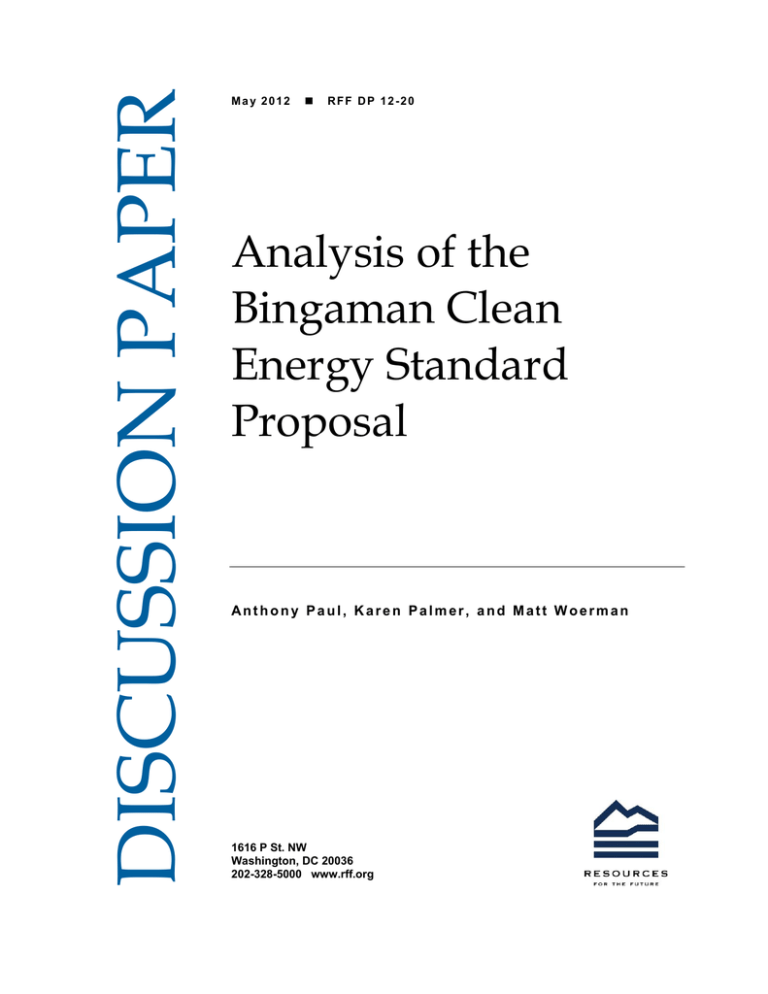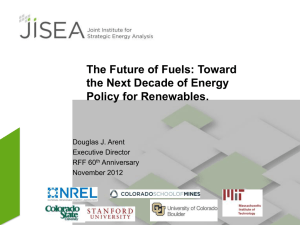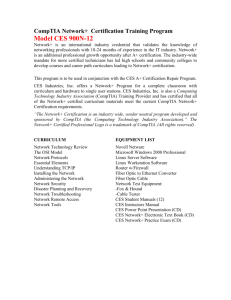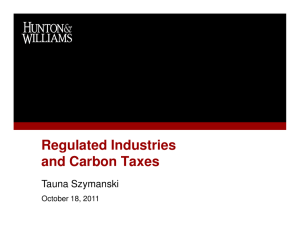
DISCUSSION PAPER
May 2012
RFF DP 12-20
Analysis of the
Bingaman Clean
Energy Standard
Proposal
Anthony Paul, Karen Palmer, and Matt Woerman
1616 P St. NW
Washington, DC 20036
202-328-5000 www.rff.org
Analysis of the Bingaman Clean Energy Standard Proposal
Anthony Paul, Karen Palmer, and Matt Woerman
Abstract
A clean energy standard (CES) is a flexible approach to encouraging a cleaner technology mix for
electricity production. The most recent federal CES proposal from Senator Bingaman would transform the
way electricity is produced and result in substantial reductions in CO2 emissions with small national
average electricity price effects through 2025. After 2025, electricity prices would increase substantially.
The alternative compliance payment (ACP) for clean energy credit will be binding, and thus actual
deployment of clean energy will fall short of the intended targets and cumulative emissions reductions by
2035 will be 12 percent smaller than they would be without an ACP. The small utility exemption from the
CES requirements equates to roughly $29 billion in avoided electricity expenditures by the customers of
exempted utilities in 2035 alone. Excluding power generated by existing nuclear and hydroelectric
facilities from CES compliance responsibility raises electricity prices in competitive regions to the benefit
of owners of existing nuclear and hydro capacity.
Key Words: climate, clean energy standards
JEL Classification Numbers: Q42, Q48, Q54, Q58
© 2012 Resources for the Future. All rights reserved. No portion of this paper may be reproduced without
permission of the authors.
Discussion papers are research materials circulated by their authors for purposes of information and discussion.
They have not necessarily undergone formal peer review.
Contents
Introduction ............................................................................................................................. 1
Model and Scenarios ............................................................................................................... 3
Results ...................................................................................................................................... 5
CO2 Emissions .................................................................................................................... 5
Retail Electricity Prices....................................................................................................... 8
Electricity Supply: Generation Mix, Industry Profits, Market Size.................................. 14
Conclusion ............................................................................................................................. 18
References .............................................................................................................................. 20
Resources for the Future
Paul, Palmer, and Woerman
Analysis of the Bingaman Clean Energy Standard Proposal
Anthony Paul, Karen Palmer, and Matt Woerman
Introduction
Global climate change is one of the more compelling environmental problems of our
time, and policies to address this problem have been an important focus of environmental policy
debates in Washington for well over a decade. Several pieces of federal legislation that address
greenhouse gas emissions in the United States have been proposed or formally introduced in the
US Congress. Many of these proposals have sought to either cap or tax emissions of CO2, either
from the electricity sector or more broadly. One economywide cap-and-trade bill, HR 2454,
sponsored by Representatives Waxman (D-CA) and Markey (D-MA), was passed by the House
of Representatives in 2009, but the Senate failed to take up the measure and it did not become
law. Since that time, there has been little appetite among federal legislators for policies that
restrict carbon emissions directly. Instead, several members of Congress as well as the Obama
administration have been looking for more targeted approaches to encouraging use of clean
energy, investments in end-use energy efficiency, and development of clean energy technologies.
One approach that has been proposed to help reduce emissions from the electricity sector
is a clean energy standard. A clean energy standard (CES) sets a minimum threshold on the share
of generation that must come from clean sources, and that threshold grows over time. Like a
renewable portfolio standard (RPS), the CES is a portfolio standard and can be satisfied by
generation from a variety of clean energy sources, encompassing a broader range of generation
technologies than just renewables alone. This broad range typically includes other nonemitting
sources such as nuclear and hydroelectric and also generation from certain types of natural gas
plants. Senator Graham (R-SC) introduced a CES bill, S 20, in 2010. This bill would have
required 30 percent of electricity generation to be clean by 2030, with clean defined as
renewables, new nuclear or hydroelectric plants, coal with carbon capture and storage, and
demand-side efficiency improvements. More recently, President Obama in his 2011 State of the
Union address discussed a CES that would require 80 percent of electricity to be clean by 2035,
crediting natural gas combined cycle as a partially clean technology.
The authors are Center Fellow in the Center for Climate and Electricity Policy, Senior Fellow, and Senior
Research Assistant, respectively, at Resources for the Future. The authors wish to thank Adam Stern for creating the
maps.
1
Resources for the Future
Paul, Palmer, and Woerman
This analysis focuses on the most recent proposal, sponsored by Senator Bingaman (DNM), which is the Clean Energy Standard Act of 2012, or S 2146.1 This CES bill sets the clean
energy requirement at 24 percent in 2015, rising by 3 percent per year to 84 percent in 2035. The
CES obliges any nonexempt retail utility to hold a fraction of a clean energy credit equal to the
requirement for each MWh of retail electricity sales. Generators designated as clean, and
therefore qualified to receive clean energy credits for electricity production, are those that are
renewable, natural gas, hydro, nuclear, or qualified waste-to-energy facilities that were placed in
service after 1991. Generators qualifying as clean receive 1-(X/0.82) credits per MWh of
generation, where X is the carbon intensity of a generator in metric tons of CO2 per MWh.2 Thus
renewables with no CO2 emissions will receive a full credit, while generators with CO2
emissions rates above zero but less than 0.82 metric tons of CO2 per MWh of generation, such as
natural gas combined cycle units or coal with CCS, will receive partial credits.3 Credits may be
banked for use in future years. Retail utilities have the option of paying an alternative
compliance payment (ACP) of $30/MWh in 2015,4 rising by 5 percent per year in real dollars in
lieu of purchasing clean energy credits, and thus the ACP imposes a ceiling on the price of
credits. Small utilities are exempt from compliance obligation, and the threshold defining small
utilities is 2 million MWh of sales per year in 2015, falling by 100,000 MWh per year to 1
million MWh of sales per year in 2025. The threshold is constant after 2025. Any electricity
sales generated by a nuclear or hydro facility placed in service before 1992 (almost all of them)
are also exempt from the standard.
This analysis looks at the effects of the CES on generation, retail prices, and CO2
emissions from the electricity sector. We analyze the effects of different aspects of the policy, as
well as how the policy performs under different assumptions about natural gas prices and new
1
For prior analyses of CES policies, see Mignone et al. (2012), Paul et al. (2011), Palmer et al. (2010). For a
discussion of the merits of an intensity based approach to a CES, see Aldy (2011).
2
From our reading of the bill, the only coal boilers eligible to receive credits for biomass cofiring are those built
after 1991. There are fewer than 20 GW of such capacity, and to receive credits, a generator must achieve a carbon
intensity below 0.82 metric tons CO2 per MWh. Even if the secretary of energy assigns an emissions rate of zero for
biomass, it is still unlikely that many of the 20 GW of potentially eligible capacity could reach 0.82. And if the
technical limit on cofiring is 10 percent of heat input, then at most 2 GW could cofire. We make the simplifying
assumption that cofiring is not credited.
3
We also assume that renewable generators who get credit under a state RPS program may also earn credits under
the federal CES program. This assumption means that generators located in states that have more aggressive RPS
policies than that implied by the federal CES policy are able to export CES credits to utilities located in other states
for compliance with the federal policy.
4
$30/MWh in 2015 dollars is approximately equal to $26/MWh in 2009 dollars, which are used for this analysis.
2
Resources for the Future
Paul, Palmer, and Woerman
environmental regulations of mercury and toxics specified in the Mercury and Air Toxics
Standards (MATS). Our results suggest that the CES leads to substantial reductions in CO2
emissions from the electricity sector. The CES will have a modest effect on the national average
retail electricity price for the first 10 years, followed by important increases after 2025. The
alternative compliance payment for clean energy credit will be binding, and thus actual
deployment of clean energy will fall short of the intended target. The exemption granted to small
utilities is extremely valuable to their customers, especially by 2035, when wholesale electricity
prices across the country will be substantially lower than they would be without the policy. The
exclusion of nuclear and hydroelectric capacity built before 1992 is valuable to those generators
if they sell power into competitive markets and costly for retail customers in those markets. The
detailed results are discussed below.
Model and Scenarios
This analysis uses RFF’s Haiku electricity market model (Paul et al. 2009) to look at the
implications of the details of the Clean Energy Standard Act of 2012. The Haiku model contains
dynamic, price-responsive modules for electricity demand and supply that are calibrated to the
Energy Information Adminstration’s (EIA) forecasts in its reference case projections, but which
can vary from these forecasts according to information and policies represented in the model.
The model simulation horizon is the year 2035. The assumptions underlying the baseline and
policy scenarios are described below.5
One core and two alternative baseline scenarios underpin this anlysis. The scenario
labeled Baseline is the core baseline. It includes all of the major environmental policies affecting
the US power sector, including the SO2 trading program under Title IV of the Clean Air Act, the
Clean Air Interstate Rule (CAIR), the Regional Greenhouse Gas Initiative (RGGI), the federal
renewable energy production and investment tax credit programs, and all of the state RPS and
renewable tax credit programs. The Baseline scenario is calibrated to the EIA’s Annual Energy
Outlook (AEO) 2011.
5
The bill contains provisions for combined heat and power, carbon capture and sequestration (CCS), and potentially
funding for end-use energy efficiency programs through the use of alternative compliance payment revenue that are
not fully captured by the Haiku model. The only provision among these three that is captured at all is that on CCS.
Haiku simulates new investments in CCS equipment in conjunction with construction of new coal-fired integrated
gasification combined cycle generators, but not CCS retrofit at existing coal boilers.
3
Resources for the Future
Paul, Palmer, and Woerman
The scenario labeled Low Gas Supply is identical to the Baseline except that the natural
gas supply module is calibrated to AEO 2009 instead of 2011. The AEO 2009 was much less
optimistic than the 2011 version regarding natural gas supply, so the Low Gas Supply scenario is
a high natural gas price scenario. The scenario labeled MATS is identical to the Baseline, but
with the Environmental Protection Agency’s (EPA) proposed MATS rule imposed.
The central policy case for this analysis, which corresponds to the text of the bill, is
labeled CES. This scenario captures all of the features of the bill described in the introduction.
The scenario labeled CES w/o ACP is identical to the CES scenario, but without the alternative
compliance payment provision. The CES w/o SUE scenario is identical to CES, but without the
small utilities exemption. The scenario labeled CES w/o ACP or SUE is CES without either ACP
or SUE. The two scenarios labeled CES w/ Low Gas Supply and CES w/ MATS represent the bill
as written, but with alternative assumptions about natural gas supply and the presence of MATS.
The scenario labeled CES w/o Nuke/Hydro Excluded is identical to CES, but without the
provision that excludes from compliance obligation all sales from generation at pre-1992 nuclear
and hydroelectric generators, and with the CES requirement adjusted to maintain a constant share
of generation from clean sources across the two scenarios.6 Note that almost all existing nuclear
and hydroelectric generation capacity was constructed before 1992, so henceforth this document
will refer in this context to existing nuclear and hydroelectric capacity without making the pre
1992 distinction.
A scenario labeled Carbon Tax is included in the analysis. This scenario finds a carbon
tax trajectory that begins in 2015, rises at 5 percent per year in real dollars, and achieves
cumulative CO2 emissions by 2035 that are equivalent to those under the CES scenario.
6
If generation from existing nuclear and hydroelectric capacity were not excluded from compliance obligation, then
if the CES requirement is as specified in the bill, the credit prices would rise (if there were no ACP) in response to
increased demand for credits. To isolate the effect of excluding existing nuclear and hyrdroelectric generators while
maintaining an approximate equivalence in environmental outcomes, the CES requirement is adjusted from 24
percent in 2015 and 84 percent in 2035 to 16 percent in 2015 and 61 percent in 2035.
4
Resources for the Future
Paul, Palmer, and Woerman
Results
All dollar values are in 2009 dollars.
CO2 Emissions
The proposed CES legislation would reduce CO2 emissions substantially. Figure 1 shows
the emissions trajectories for the Baseline and CES scenarios and for alternative approaches to
CO2 emissions mitigation. CES would achieve 11.4 billion tons of cumulative CO2 emissions
reductions by 2035, or 21 percent of cumulative Baseline emissions. In 2035 alone, CES would
achieve 1.1 billion tons of reductions, or 41 percent of annual emissions in Baseline. The United
States has pledged, as part of the United Nations climate change conferences in Copenhagen and
Cancun, to reduce economy-wide CO2 emissions to 83 percent below 2005 levels by 2050. To
be on a linear path to meet this goal, the United States would have to reduce total CO2 emissions
in 2035 by roughly 4.1 billion tons from 2005 levels, so CES would contribute 27 percent of the
United States’ pledged CO2 emissions reductions in 2035.
Figure 1. Annual CO2 Emissions (billion tons)
3.0
2.5
2.0
1.5
1.0
0.5
0.0
2010
2015
Baseline
2020
CES
2025
CES w/o ACP or SUE
5
2030
Carbon Tax
2035
Resources for the Future
Paul, Palmer, and Woerman
Table 1. CO2 Emissions (billion tons)
Annual
Emissions
in 2035
2.6
% Change
from
Baseline
Cumulative
Emissions
by 2035
55.5
% Change
from
Baseline
CES
CES w/o ACP
CES w/o SUE
CES w/o ACP or SUE
CES w/o Nuke/Hydro Excluded
1.5
0.9
1.4
0.6
1.6
–41%
–65%
–44%
–78%
–40%
44.1
37.3
43.3
29.7
44.2
–21%
–33%
–22%
–46%
–20%
MATS
CES w/ MATS
Low Gas Supply
CES w/ Low Gas Supply
2.6
1.4
2.7
1.7
–1%
–45%
3%
–35%
54.9
41.8
57.9
48.7
–1%
–25%
4%
–12%
Carbon Tax
1.8
–30%
44.7
–20%
Baseline
The ACP provision of the bill is important because, in this deterministic analysis, it binds
at all times. Expressed in 2009 dollars, the ACP starts out at $26/MWh in 2015 and rises by 5
percent per year in real dollars to $68/MWh in 2035. Without an ACP, the clean energy credit
price would reach $36/MWh in 2015 and $92/MWh in 2035 (CES w/o ACP scenario). Indeed,
the binding ACP will prevent the fraction of power supplied by clean sources in the CES
scenario from reaching the requirements specified in the bill. The elevated credit prices in the
CES w/o ACP would engender a greater fraction of generation from clean sources and more
emissions reductions, amounting to an additional 12 percent of cumulative emissions reductions
by 2035 beyond those reductions projected under the CES scenario.
Another important provision of the bill is the small utilities exemption (SUE), which, like
the ACP, will prevent the fraction of electricity produced by clean sources from reaching the
levels specified in the bill. Because of the presence of the ACP, the SUE has only a small effect
on emissions, though the economic consequences are not small, as will be subsequently shown.
In the absence of both ACP and SUE (CES w/o ACP or SUE scenario), cumulative emissions
reductions of 46 percent relative to Baseline would be achieved, an additional 25 percent beyond
the reductions projected under the bill. Without these two provisions, the policy would contribute
approximately half of the United States’ pledged CO2 emissions reductions in 2035, as discussed
above.
6
Resources for the Future
Paul, Palmer, and Woerman
The exclusion of generation from existing nuclear and hydroelectric capacity from
compliance responsibility is another aspect of the bill with evident consequences. Special
treatment for these technologies is born from the fact that even though many such facilities have
very low variable costs, and would therefore produce an identical amount of power under CES
regardless of whether their production receives clean energy credit, this will not hold for all
facilities. For facilities that would reduce production under CES without any credit, exclusion
from compliance obligation will reverse this effect, keeping that clean production on line.
The CO2 emissions consequences of the exclusion for existing nuclear and hydroelectric
capacity are revealed by comparing the CES w/o Nuke/Hydro Excluded scenario to the CES.
Until 2035, less than 10 TWh of annual generation by existing nuclear facilities is preserved by
the exclusion provision, but 29 TWh (3 percent of total generation from existing nuclear
facilities) are preserved in 2035. This change in generation would not be accompanied by a
change in capacity, and 17 TWh of the generation that would be lost without the exclusion are
made up by additional generation at new nuclear facilities. Since most of the existing nuclear
generation that is preserved by the exclusion provision is offset by reductions in new nuclear
generation, the emissions effects of the provision are small.
Natural gas price uncertainty is an important consideration in projecting the future of the
electricity sector under any policy scenario. CO2 emissions under the AEO 2009 assumptions for
natural gas supply (Low Gas Supply scenarios) are substantially different from their AEO 2011
counterparts (Baseline and CES scenarios). The relatively high natural gas prices in the Low Gas
Supply scenarios lead to a substitution between coal and gas that results in greater cumulative
emissions under both baseline and CES conditions. However, the difference is greater under a
CES policy, resulting in fewer cumulative emissions reductions from CES if low gas supply
conditions prevail.
The existence of EPA’s MATS regulation (CES w/ MATS scenario) would compound the
CO2 emissions reductions of CES, achieving an additional 4 percent cumulative reductions from
Baseline. Another way to think of this is that CES would set up MATS to achieve 4 percent
cumulative reductions as an ancillary benefit of the EPA regulation.
The Carbon Tax scenario has cumulative emissions by 2035 that closely match those of
the CES scenario, but the trajectory is somewhat different, with more reductions occurring in the
short run and fewer occurring later in the simulation horizon. The CO2 tax trajectory that
engenders these emissions would start at $10/ton in 2015 and reach $23/ton in 2035. Further
results will speak more to the differences between Carbon Tax and CES.
7
Resources for the Future
Paul, Palmer, and Woerman
Retail Electricity Prices
The retail electricity price effects of a CES will be substantial in the long run, but prices
would be affected only moderately in the first decade of the policy. In the initial years of the
program, the CES credit prices and credit requirements will be relatively low, yielding virtually
no effect on electricity prices. During the same initial period, the CES policy will encourage
expanded investment in and averted retirement of natural gas capacity. Coal capacity will be
retired under a CES, but during this initial period the increase in natural gas capacity will exceed
the decrease in coal capacity. In the CES scenario in the year 2020, the change relative to
Baseline in natural gas capacity exceeds that of coal capacity, resulting in 20 GW more total
capacity under CES than under Baseline. Most of this capacity expansion occurs in the regions of
the country that price electricity in competitive markets, which are the regions where capacity
expansion tends to drive down electricity prices because marginal costs determine prices. In
these regions, the price dampening effect of capacity expansion is approximately offset by the
small increase in prices that follows from the obligation to hold clean energy credits. The net
effect is approximately no change in retail prices under a CES in competitive regions in the short
run. In cost-of-service regions, where prices are governed by average (or total) costs, the small
short-run increase in prices resulting from credit requirements is offset by small reductions in
costs resulting from a net export of credits to competitive regions. These countervailing effects
of CES yield approximately no short-run electricity price impacts for the nation as a whole. In
the long run, the cost of the credit obligation increases as both the credit price and requirement
rise, trumping all other factors affecting electricity prices. By 2035, the national average retail
electricity price under CES would exceed that of the Baseline scenario by $16/MWh (18
percent).
8
Resources for the Future
Paul, Palmer, and Woerman
Figure 2. National Average Electricity Prices ($/MWh)
140
120
100
80
60
40
20
0
2010
2015
Baseline
2020
CES
2025
CES w/o ACP or SUE
2030
2035
Carbon Tax
106
Change
from
Baseline
Regulated
Average
Change
from
Baseline
Competitive
Average
Change
from
Baseline
National
Average
Table 2. Average Electricity Prices in 2035 ($/MWh)
Baseline
92
CES
CES w/o ACP
CES w/o SUE
CES w/o ACP or SUE
CES w/o Nuke/Hydro Excluded
108
111
115
130
103
16
20
23
38
12
116
122
120
141
100
9
16
14
35
-6
104
106
112
125
105
19
21
27
40
20
MATS
CES w/ MATS
Low Gas Supply
CES w/ Low Gas Supply
92
108
96
112
1
17
4
20
106
115
117
122
0
9
11
16
86
105
87
107
1
20
2
22
Carbon Tax
107
16
117
11
103
18
9
85
Resources for the Future
Paul, Palmer, and Woerman
The ACP and SUE provisions of the bill both serve to dampen any electricity price
increases resulting from CES. If both provisions were struck from the policy (CES w/o ACP or
SUE scenario), national average prices would reach $130/MWh by 2035, or 42 percent above
Baseline, which is 24 percentage points higher than the 18 percent effect of CES. Especially
effective in reducing average price impacts is the SUE, which causes prices to be only 18 percent
above Baseline in 2035, as opposed to 25 percent above Baseline without the SUE. Without the
ACP, prices increase by only an additional 4 percent above CES for a total price effect of 22
percent over Baseline.
The benefits to consumers of a reduced electricity price due to the SUE accrue
exclusively to those consumers who buy electricity from utilities that qualify for the SUE. Based
on the 2009 distribution of utility sizes, we determined the fraction of regional consumption that
would be exempted under each level of the threshold. By 2025 and thereafter, the SUE is
projected to exempt 12.5 percent of national electricity consumption under CES from any
compliance obligation. This means that the benefits of the $7/MWh difference in national
average prices in 2035 between CES and CES w/o SUE is concentrated in the hands of the
consumers of only 12.5 percent of total sales. With the SUE under the CES scenario, consumers
served by the exempted utilities pay an average retail electricity price of only $52/MWh in 2035
(assuming these utilities have the regional average mix of generating technologies), while the
remaining consumers pay an average price of $116/MWh. Regional differences cause an even
greater discrepancy between retail prices across the country. For example, consumers of
exempted utilities in the Northwest pay only $12/MWh in 2035, but consumers on Long Island,
where the SUE exempts no consumers, pay $175/MWh. Under the CES w/o SUE scenario,
however, consumers served by utilities that would have been exempted by the SUE face an
average retail price of $109/MWh, and all other consumers still pay an average of $116/MWh. In
other words, the SUE allows consumers of 12.5 percent of total sales to enjoy an average retail
electricity price reduction of $57/MWh, while consumers of the remaining 87.5 percent see no
benefit at all. This price difference, applied to the 12.5 percent of 4,085 TWh of national
consumption in 2035 under CES that are exempted by the SUE, amounts to an electricity
expenditure savings of $29 billion.
If there were no ACP, the SUE would reduce the consumption basis for the CES, which
would in turn reduce the total amount of clean energy required by the policy, the credit price, and
electricity prices for all consumers. However, for both of these scenarios, the ACP is binding, so
clean energy generation is unchanged. Instead, the effect of the SUE is to reduce the ACP
revenues received by state governments for end-use energy efficiency programs. In the absence
10
Resources for the Future
Paul, Palmer, and Woerman
of a rationale for an SUE provision on efficiency grounds, it is unclear why the substantial
redistribution of wealth embodied in the SUE is desirable for other than political reasons.
The exclusion for existing nuclear and hydroelectric generators is effectively innocuous
for the regions of the country that price electricity by cost-of-service regulation. In the
competitive-pricing parts of the country, the exclusion amounts to a wealth transfer from
consumers to the owners of existing nuclear and hydroelectric generators. In some states, like
New York, where some hydroelectric capacity is publicly owned, the ratepayers presumably will
recapture part of the wealth transfer, but that does not occur in these model results. In other
cases, especially with respect to nuclear capacity, the transfer will remain with utility
shareholders.
The scenarios covering alternative assumptions about gas supply and the existence of
MATS yield little of interest in terms of electricity price effects. Less supply of natural gas tends
to raise prices and tends to do so at a rate that is largely independent of the presence of CES.
MATS tends to raise prices, though by only a small percentage, and this effect is also largely
independent of the presence of CES.
The Carbon Tax scenario reveals an electricity price trajectory that is uniformly greater
than the prices under CES until 2035. These higher prices have the potential to facilitate costeffective CO2 emissions reductions, since they account for the social cost of emissions, but
ultimately cost-effectiveness hinges on the allocation of tax revenues. Further analysis of this
issue is beyond the scope of this paper.7
In the case of a CES policy, an analysis of national average prices alone is insufficient
because the national averages obscure substantial regional variation in the effects. This variation
is brought about by the aforementioned regulatory regimes for electricity pricing (market-based
versus cost-of-service), the composition of the existing generation fleet, and the size of local
utilities with respect to the threshold for the small utility exemption.
Figure 3 displays the regional price effects of the CES w/o SUE scenario in 2035, which
allows for an examination of the price effect of the CES due to regulatory structure and the
regional variation of the existing generation fleet without the regional effects of the SUE. The
value label in each region shows the average retail electricity price in the Baseline scenario, and
the color of each region represents the regional price effect of CES w/o SUE. In general, the
7
Parry and Williams (2011) discuss the efficiency implications of the use of carbon tax revenues.
11
Resources for the Future
Paul, Palmer, and Woerman
regions that would otherwise enjoy the lowest-priced electricity will endure the largest price
increases under the bill, with the Pacific Northwest a notable exception. However, the regional
variation in the baseline is big enough that these low-price regions that endure the largest price
increases would still tend to pay among the lowest prices in the country, generally still below the
national average. The regions that have the highest Baseline prices would tend to see small price
increases, and still pay prices above the national average. Overall, CES w/o SUE would tend to
reduce the regional variation in electricity prices that would otherwise exist under Baseline.
Figure 3. Regional Retail Electricity Price Effects of CES w/o SUE in 2035 ($/MWh)
Since the country is heterogeneous in the size of local utilities, the regional impact of the
SUE is also heterogeneous. Figure 4 shows the price impacts of the SUE in 2035. The color and
labeling scheme for this figure is unlike that of the last. Here, the color intensity indicates the
price effect of the SUE relative to CES, with red indicating a price decrease due to the SUE and
blue indicating a price increase, and the value labels within each region are the projected
Baseline prices. In general, the SUE provision of the CES tends to increase regional variation in
12
Resources for the Future
Paul, Palmer, and Woerman
retail electricity prices under CES. Most of the regions that have the lowest electricity prices in
Baseline, including the Northwest, Plains, and Appalachia, would experience moderate to large
price decreases due to the SUE. On the other hand, most of the regions that have the highest
prices in Baseline, including California, the Northeast, and Florida, would experience small to
moderate price decreases.
Figure 4. Regional Retail Electricity Price Effects of the SUE in 2035 ($/MWh)
The net price impact of CES in 2035, due to the combination of these regional effects, is
shown in Figure 5. Much of the leveling effects of the non-SUE regional differences (seen in
Figure 3) are undone by the inclusion of the SUE provision (seen in Figure 4). The result is that
the regions with a relatively clean mix of generators or a relatively high proportion of small
utilities would experience a relatively small average retail price increase due to the CES, while
most of the rest of the country would experience larger increases.
13
Resources for the Future
Paul, Palmer, and Woerman
Figure 5. Regional Retail Electricity Price Effects of CES in 2035 ($/MWh)
In 2020, the national average effect of CES on electricity prices would be effectively
zero, but this obscures some regional variation. Figure 6 shows these regional results, revealing
that the regions of the country that rely most on coal-fired generation stand to experience small
retail price increases, while the Northeast and Texas stand to pay substantially less for electricity
with CES than without it.
14
Resources for the Future
Paul, Palmer, and Woerman
Figure 6. Regional Retail Electricity Price Effects of CES in 2020 ($/MWh)
Electricity Supply: Generation Mix, Industry Profits, Market Size
The proposed CES legislation would drastically alter the composition of electricity
supply in the long run, with a huge decline in coal-fired generation being the most pronounced
effect, as shown in the right-hand panel of Figure 7. The roughly 1,200 TWh decline in coal
generation would be offset partially by about a 330 TWh decline in consumption.8 Offsetting the
remainder of the lost coal generation would be a variety of new generation sources. Large growth
in natural gas generation (about 600 TWh) would be accompanied by more moderate growth in
wind and nuclear generation (about 100 and 140 TWh, respectively). In the short run by 2020,
the CES will affect a swap of generation from coal to natural gas of almost 600 TWh.
8
To be precise, generation declines by 360 TWh because of a smaller decline in consumption. The difference is due
to losses in transmission and distribution.
15
Resources for the Future
Paul, Palmer, and Woerman
The Carbon Tax scenario achieving the same cumulative CO2 emissions as the CES
scenario by 2035 would yield a substantially different configuration of the electricity generation
fleet than CES. The 59 percent decline in coal generation under CES would be reduced to 37
percent under Carbon Tax. Higher electricity prices under Carbon Tax through 2030 than under
CES would engender slightly lower demand in 2035. These two factors reduce the demand for
new sources of generation, with the reduction in new source growth shared among natural gas,
wind, and nuclear generation.
Figure 7. National Generation Mix (TWh)
2020
2035
5,000
4,500
4,000
3,500
3,000
2,500
2,000
1,500
1,000
500
0
Other
Wind
New Nuclear
Nat Gas
Steam Coal
Hydro
Existing Nuclear
Baseline
CES
Carbon Tax
Baseline
CES
Carbon Tax
CES would lead to lower utility profits, as shown in Figure 8, amounting to almost $90
billion in net present value (NPV) terms through 2035. These losses would be borne by utilities
selling power into the competitive electricity markets (profits for cost-of-service regulated
utilities are zero by construction), but these utilities would remain profitable, accumulating about
$140 billion by 2035 in discounted terms. In combination, the ACP and SUE provisions of the
bill have little effect on industry profits in discounted terms, with profits about $10 billion
greater in NPV under CES than they would be without ACP and SUE. This near equivalence in
NPV profits is manifest in greater short-run profits under the bill than without ACP and SUE, but
fewer profits in the most distant years. A Carbon Tax would lead to a small positive effect on
industry profits of about $10 billion in NPV terms. This increase results from higher production
costs and reduced sales under Carbon Tax being offset by higher electricity prices. Indeed, the
growth in revenue would much more than offset growth in costs, with the difference being
carbon tax revenue collected by the government on top of the $10 billion retained by producers.
In the Carbon Tax scenario, there are about $300 billion of discounted carbon tax revenues
through 2035.
16
Resources for the Future
Paul, Palmer, and Woerman
Figure 8. National Electricity Sector Producer Surplus (billion $)
40
35
30
25
20
15
10
5
0
2010
2015
Baseline
2020
CES
2025
CES w/o ACP or SUE
2030
2035
Carbon Tax
A potentially important aspect of CES is that it will transform the composition of the
revenue stream received by electricity producers. The change in retail electricity prices under
CES will be much smaller than, and in the opposite direction from, the change in wholesale
prices. Over time CES will substantially depress wholesale prices, with the lost revenues to
generators in electricity markets being replaced by revenues in clean energy credit markets.
Figure 9 shows the components of utility revenue streams under Baseline and CES.9 The top
portion of the CES panel shows revenues from credit sales to electricity retailers and the other
portions (blue, red, and purple) show revenues from electricity sales. NPV of electricity sales
declines by about $700 billion through 2035 under CES, replaced by about $780 billion of
revenues from clean energy credits, with total NPV revenues rising by 1.5 percent. In 2035, 36
percent of industry revenues would come from credit sales.
The “Other” category includes transmission and distribution, taxes, and a calibrator. For cost-of-service regions,
the distinction between energy and capacity revenues is a modeling artifact of the ratio between the marginal value
of generation and capacity.
9
17
Resources for the Future
Paul, Palmer, and Woerman
Figure 9. Components of Electric Utility Revenue (billion $)
Baseline
450
400
350
300
250
200
150
100
50
0
2010
CES
450
400
350
300
250
200
150
100
50
2015
2020
0
2025
2010
2030
2015
Energy
2035
2020
2010
2025
Capacity
Other
2015
2030
2020
2035
2025
2030
2035
CES Credits
This transformation of the revenue stream for generators means that a growing portion of
volatility in electricity prices, which matters to both consumers and electricity sector investors,
will come to depend not just on the factors that have historically driven electricity prices, but
now also on credit price stability. Considering the relative lack of volatility in historical
electricity prices, the threshold for credit price volatility to lead to greater electricity price
volatility under CES is not high. Considering the size of the credit market, electricity prices
could be highly vulnerable to credit price volatility, though credit price volatility would be partly
offset by responsive wholesale electricity prices. The implications of this transformation of the
revenue stream under a CES are a ripe topic for further research. A carbon tax would bring about
no such transformation in revenue streams.
Conclusion
US federal legislators have not been willing to impose direct limits on emissions of CO2,
so those who wish to promote cleaner energy are focusing on alternative approaches. A clean
energy standard is a flexible approach to encouraging a transition to a cleaner technology mix for
electricity production that has grabbed the attention of energy policy makers and policy
watchers. If enacted as written, the most recent federal proposal from Senator Bingaman would
transform the way electricity is produced and result in substantial reductions in CO2 emissions
and increases in electricity prices after 2025. Price effects in the short-run would be small and
potentially negative in some regions. Although the future of this policy is highly uncertain, its
effects on electricity consumers and producers in different parts of the country will depend
importantly on a few key features of the policy.
One such provision is the alternative compliance payment (ACP), which caps the price of
clean energy credits at a level that grows over time. This analysis suggests that the ACP will be
18
Resources for the Future
Paul, Palmer, and Woerman
binding, which implies that the policy will fall short of its stated goals for clean energy
generation, achieving 12 percent fewer cumulative reductions of CO2 emissions by 2035 than it
would in the absence of the ACP. The ACP does help mitigate retail electricity price increases.
Another important provision is the small utility exemption, which exempts utilities with
fewer than 2 million MWh of sales initially, and utilities with under 1 million MWh of sales
ultimately, from having to comply with the standard. From 2025, the small utility exemption
affects roughly 12.5 percent of the electricity sold in the contiguous United States. This provision
has a much larger effect on national average retail electricity price than the ACP and in total
amounts to an electricity expenditure savings of roughly $29 billion in 2035. Because the ACP is
binding, the small utility exemption reduces the amount of ACP revenues that state governments
receive for energy efficiency programs. The effect of the exemption on electricity prices also
varies substantially across regions of the country, with the consumers of 12.5 percent of national
electricity demand collecting the entire value of the exemption.
The exclusion of power generated by existing nuclear and hydroelectric facilities from
CES compliance responsibility is a third important provision of the bill. There is almost no effect
on emissions from the exclusion, but there is an important wealth transfer from consumers in
competitive-pricing parts of the country to the owners of existing nuclear and hydroelectric
generators that sell power to those consumers. The average electricity price effect of the
exclusion in competitive regions would be $16/MWh in 2035.
Over time, the CES policy will change the way the electric utility industry raises
revenue. As the standard gets higher and the ACP increases, the market price of credits rises and
generators find themselves getting an increasingly larger share of their revenues from the sale of
credits as opposed to electricity per se. By 2035, 36 percent of revenues would be from credit
sales. This transformation means that the performance of credit markets will have important
implications for the prices that consumers pay for electricity in the future under such a policy.
19
Resources for the Future
Paul, Palmer, and Woerman
References
Aldy, J. 2011. Promoting Clean Energy in the American Power Sector. Hamilton Project
Discussion Paper 2011-04, May.
Mignone, Bryan, Thomas Alfstad, Aaron Bergman, Kenneth Dubin, Richard Duke, Paul Friley,
Andrew Martinze, Matthew Mowers, Karen Palmer, Anthony Paul, Sharon Showalter,
Daniel Steinberg, Matt Woerman, and Frances Wood. 2012. Cost Effectiveness and
Economic Incidence of a Clean Energy Standard.
Palmer, K., R. Sweeney, and M. Allaire. 2010. Modeling Policies to Promote Renewables and
Low Carbon Sources of Electricity. Backgrounder. Washington, DC: Resources for the
Future. June.
Parry, Ian, and Roberton Williams. 2011. Moving US Climate Policy Forward: Are Carbon
Taxes the Only Good Alternative? Discussion Paper 11-02. Washington, DC: Resources
for the Future.
Paul, A., D. Burtraw, and K. Palmer. 2009. Haiku Documentation: RFF’s Electricity Market
Model Version 2.0. Report. Washington, DC: Resources for the Future.
Paul, A., K. Palmer, and M. Woerman. 2011. Clean Energy Standards for Electricity: Policy
Design Implications for Emissions, Supply, Prices and Regions. Discussion Paper 11-35.
Washington, DC: Resources for the Future.
20








